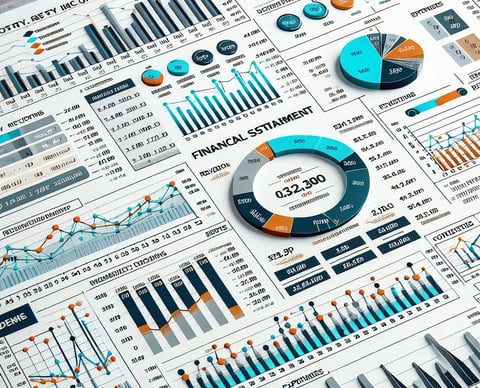"Unlock the secrets to smart investing and stay informed on the latest trends in Indian business and finance."
NACDAC Infrastructure IPO
If you're seeking investment opportunities in the infrastructure sector, investing in this IPO could be a promising option for you.
CA Narendra Rajpoot
12/16/202410 min read
1. About the Company..
NACDAC Infrastructure is a cpntruction company that offers various civil and structural services. The company focuses on building multi-storey structures, performing electrical works (both low and high tension), steel structure construction, and building bridges, including foot overbridges (FOBs) and road overbridges (ROBs). NACDAC Infrastructure handles contracts independently or collaborates through project specific joint ventures with other construction and infrastructure companies. In addition to this, the company also takes on sub-contracting projects from major third party infrastructure and construction firms.




2. Strengths
Over the years, NACDAC Infrastructure has completed 63 projects for a total value of approximately Rs. 96.75 crore.
The company is ISO 9001:2015 certified for quality management systems, ISO 14001:2015 certified for environment management systems, and ISO 45001:2018 certified for occupational health and safety management systems.
NACDAC Infrastructure offers a wide range of construction and structural services and claims that this diversity has helped the company cater to broad client base and strengthen its position in the market.
The company has seen a consistent increase in revenue from operations and profit after tax(PAT). Revenue from operation increased from Rs. 10.31 crore in FY22 to Rs. 11.72 crore in FY23 to Rs. 36.30 crore in FY24, PAT increased from Rs. 0.31 crore in FY22 to Rs. 0.56 crore in FY23 to Rs. 3.17 crore in FY24.


3. Risks
NACDAC Infrastructure's business is dependent on projects in the state of Uttarakhand, Uttar Pradesh, and Delhi. As of October 31, 2024, the company generated 41.43% of its total revenue from operations from Uttarakhand, 31.83% from Uttar Pradesh, and 24% from Delhi. Any adverse changes to the business environment in these states could negatively impact the company's operations and financial performance.
Infrastructure project are awarded to NACDAC Infrastructure based on meeting specific prequalification criteria and through a competitive bidding process. The company's business and financial stability could be adversely affected if new projects are not awarded, or if existing contracts are terminated prematurely.
A large portion of the company's revenue comes from a small group of clients. The top 10 customers contributed 96.05%, 91,93%, 87.86%, and 99.98% for the period ending October 31, 2024, and in the FY24, FY23 and FY22, respectively to the total sales. Any loss of any major client or reduction in business from them could adversely impact the company's operations and finances.
The company, its director and promoters are currently involved in certain ongoing legal proceedings. Any adverse judgements in any of these cases could be detrimental to the company's business prospects.
As of October 31, 2024, the company's total outstanding borrowings amount to Rs. 8.11 crore. Any inability to repay or services these loans could adversely affect the company's financial position.


4. About the Financials..
Net profit - Net profit of the company is significantly increased from the past year. In March 2022 the profit was Rs. 0.32 crore and in March 2023 the profit was Rs. 0.56 crore and in March 2024 profit was Rs. 3.17 crore.
Reserves - The company is concentrating on enhancing its reserves. In March 2022, the reserves were valued at Rs. 0.48 crore, which increased to Rs. 1.17 crore in March 2023, and further rose to Rs. 4.34 crore in March 2024.
The company's focus on enhancing its reserves is a positive sign of financial growth and stability. The significant increase in reserves—from Rs. 0.48 crore in March 2022 to Rs. 4.34 crore in March 2024—indicates a strong upward trajectory. This substantial rise suggests effective financial management and possibly improved profitability, allowing the company to retain more earnings for future growth or unforeseen contingencies.
The growth in reserves also reflects a prudent approach to securing the company's long-term sustainability, which could make it more resilient in the face of market volatility or other challenges. Additionally, a higher reserve base can help build investor confidence, as it demonstrates the company's ability to generate and manage funds effectively.
Borrowings - The company's borrowings were Rs. 1.90 crore in March 2022, which decreased to Rs. 0.09 crore in March 2023, before rising to Rs. 6.43 crore in March 2024.
While the company demonstrated strong debt reduction in the previous year, the recent increase in borrowings could indicate a strategic move to fund growth opportunities or manage cash flow requirements. The increase in debt requires careful monitoring to ensure it is used effectively and remains manageable, as it may pose higher financial risk. It will be important to assess how the company plans to utilize this new debt and whether it can maintain its ability to service these borrowings without compromising financial stability.
Other Liabilities - Other liabilities includes Trade payables, advance from customers , other liability items. Trade payable of the company increased from Rs 1.02 crore to 2.16 crore between the period Mar 2023 to Mar2024. Advance from customers reduced from Rs. 5.16 crore to Rs.3.25 crore between the period Mar 2023 to Mar2024. Other liability items increased from Rs.0.38 crore to 0.75 crore between the period Mar 2023 to Mar2024.
The company appears to be experiencing mixed financial changes. While trade payables have increased, indicating potential growth and flexibility in managing supplier relationships, the decline in advances from customers raises concerns about future cash flow from prepayments. The increase in other liabilities suggests preparations for higher future costs or obligations.
Fixed Assets - Fixed assets of the company is increased from Rs.1.78 crore to Rs.2.26 crore between the period Mar23 to Mar24 .
The increase in fixed assets is a positive sign as it shows that the company is reinvesting in its operations and positioning itself for future growth. This could enhance the company’s productivity and efficiency in the long term. However, it is important to ensure that these investments lead to improved operational performance and return on assets.
Fixed Assets - Fixed assets of the company is increased from Rs.1.78 crore to Rs.2.26 crore between the period Mar23 to Mar24 .
The increase in fixed assets is a positive sign as it shows that the company is reinvesting in its operations and positioning itself for future growth. This could enhance the company’s productivity and efficiency in the long term. However, it is important to ensure that these investments lead to improved operational performance and return on assets.
Cash Equivalents - Cash Equivalents value in Mar2022 was Rs.0.36 crore and in Mar2023 was Rs.0.56 crore and in Mar2024 was Rs.1.87 crore.
The growth in cash equivalents from Rs. 0.36 crore to Rs. 1.87 crore over the past two years is a positive sign, indicating improved financial health and stronger liquidity. This enhanced cash position provides the company with more flexibility for growth, investment, and risk management. However, the company should ensure that this cash is being used efficiently and not kept idle, as it could potentially be invested to generate higher returns.
Loans and Advance - Loans and Advances(Asset side) of the company is increasing which is a good sign in financial statement. In Mar2022 loans and advances of the company was Rs.1.85 crore and in Mar2023 was Rs.3.09 crore and in Mar2024 was Rs.5.24 crore.
The increase in loans and advances from Rs. 1.85 crore to Rs. 5.24 crore reflects growth in the company’s lending or financial support activities, which could indicate healthy business development and potential for increased income. However, it is crucial for the company to ensure that these advances are well-managed and that repayments are tracked, as any delays or defaults could impact liquidity and overall financial stability. The company should maintain a balance between leveraging loans for business growth and minimizing the risk of non-performance.
Other Assets Items - Other asset items was Rs. 0.45 crore in Mar2022 and was Rs.0.50 crore in Mar0.50 crore and was Rs. 1.31 crore in Mar2024.
The increase in Other Asset Items from Rs. 0.45 crore to Rs. 1.31 crore suggests that the company is making strategic investments in non-operational or long-term assets. While this can enhance future growth and position the company for the long term, it is essential to monitor the returns on these investments and ensure that they do not compromise the company’s liquidity or operational flexibility.




5. Cash Flow..
Cash from Operating Activity - Cash from operating activity was Rs.(-1.41 crore) in Mar2022 and was Rs.1.64 crore in Mar2023 and was Rs.(-7.62 crore) in Mar2024.
The fluctuating cash from operating activities signals that the company is facing challenges in generating consistent cash flow from its operations. The positive cash flow in March 2023 was a brief improvement, but the sharp decline in March 2024 raises red flags regarding the company's operational performance. The company needs to address underlying operational inefficiencies, reduce costs, or improve revenue generation to avoid prolonged periods of negative cash flow and ensure long-term financial stability. Effective management of working capital, cost control, and improving profitability will be critical moving forward.
Cash from Investing Activity - Cash from investing activity was Rs.(-0.05 crore) in Mar2022 and was Rs.0.00 crore in Mar2023 and was Rs.(-0.77 crore) in Mar2024.
The company’s cash from investing activities has been negative in March 2022 and March 2024, which suggests significant investments or capital expenditures in those periods. The increase in negative cash flow in March 2024 could be due to the company's strategic investments aimed at growth or expansion. However, the company must ensure that these investments are aligned with its long-term financial goals and that it maintains sufficient liquidity, especially given the negative cash flow from operating activities in March 2024. The neutral cash flow in March 2023 could indicate a temporary pause in such investments or a shift in priorities.
Cash from Financing Activity - Cash from financing activity was Rs.0.80 crore in Mar2022 and was Rs.(-1.63 crore) in Mar2023 and was Rs.8.77 crore in Mar2024.
The company has experienced significant fluctuations in cash flow from financing activities over the past three years. The positive flow in March 2022 indicates initial capital raising efforts, while the negative cash flow in March 2023 suggests a reduction in financial liabilities or repurchasing of shares. The substantial increase in March 2024 (Rs. 8.77 crore) indicates a heavy reliance on external financing, possibly through new debt or equity issuance, to support operations, investments, or to address liquidity issues.
Given the negative cash flows from operating and investing activities in March 2024, the large positive financing cash flow could be necessary to maintain liquidity, fund growth initiatives, or stabilize the company's financial position. However, it is essential for the company to ensure that it manages its financing activities prudently, as over-reliance on external financing could increase financial risk in the long term.


7. Ratios
Debtor Days - Debtor Days was 51 days in Mar2022 and was 73 Days in Mar2023 and 39 days in Mar2024.
The Debtor Days ratio shows positive improvement from 73 days in March 2023 to 39 days in March 2024, indicating that the company has taken effective steps to improve its receivables management. This decrease in Debtor Days suggests better cash flow and more efficient credit and collection processes. The prior increase to 73 days in March 2023 was a concern, but the improvement in March 2024 demonstrates that the company has likely addressed any issues related to delayed payments, improving its liquidity and reducing reliance on external financing.
Maintaining a low Debtor Days figure is important for ongoing cash flow health, and the company should continue to monitor and optimize its credit policies to ensure that it can sustain or further reduce this ratio.
Inventory Days - Inventory Days was 150 days in Mar2022 and was 210 Days in Mar2023 and 143 days in Mar2024.
The Inventory Days ratio has fluctuated significantly, with an increase from 150 days in March 2022 to 210 days in March 2023, followed by a substantial decrease to 143 days in March 2024.
The increase in 2023 could indicate potential inefficiencies in inventory management, slow-moving products, or weaker demand. However, the improvement in 2024 is a positive sign, suggesting that the company has addressed these issues, possibly through better inventory control, more effective sales strategies, or optimizing stock levels to match demand.
Maintaining an efficient inventory turnover is crucial to reduce carrying costs and improve cash flow. The company should continue focusing on improving its inventory management to ensure that the inventory is kept at optimal levels while avoiding stockouts or overstocking. The reduction in Inventory Days in March 2024 is a good sign of improved operational efficiency.
Days Payable - Days Payable was 68 days in Mar2022 and was 51 Days in Mar2023 and 31 days in Mar2024.
The Days Payable Outstanding (DPO) has decreased from 68 days in March 2022 to 31 days in March 2024, indicating a trend of the company paying its suppliers more quickly over time.
The reduction in DPO could be a positive sign of improved liquidity and cash flow management, as the company may now be in a better financial position to settle its payables promptly. However, the decrease in DPO could also mean that the company is not fully utilizing credit terms that could extend its working capital cycle and provide more liquidity for other operational needs.
In the long term, the company should aim for a balanced approach. Paying suppliers too quickly can affect cash reserves, while paying too slowly can strain supplier relationships. The company should ensure that it maintains healthy working capital management and negotiates favorable terms with suppliers without jeopardizing liquidity.
Working Capital Days - Working Capital days was 151 days in Mar2022 and was 98 Days in Mar2023 and 134 days in Mar2024.
The Working Capital Days trend reflects fluctuations in the company’s ability to efficiently manage its short-term assets and liabilities:
March 2022 (151 days): The company had a higher working capital requirement, which could indicate inefficiencies or slower movement of inventory and receivables.
March 2023 (98 days): The sharp decrease in working capital days indicates improved efficiency in managing short-term assets and liabilities, leading to better liquidity and reduced reliance on external financing.
March 2024 (134 days): The increase in working capital days suggests a decline in efficiency compared to the previous year. The company may need to revisit its inventory, receivables, and payables management to ensure that it is optimizing its working capital and maintaining liquidity.
To optimize working capital, the company should focus on improving inventory turnover, speeding up receivables collection, and potentially renegotiating payment terms with suppliers to reduce the working capital days further. Effective management of working capital is crucial for sustaining cash flow and supporting business growth without relying excessively on external financing.
ROCE % - In Mar2022 ROCE % was 10.34% and In Mar2023 ROCE% WAS 15.64% , and in Mar2024 ROCE% was 40.10%.
The ROCE has shown a dramatic improvement from 10.34% in March 2022 to 40.10% in March 2024:
March 2022: A ROCE of 10.34% indicates the company was generating moderate returns on its capital employed.
March 2023: The increase to 15.64% signals an improvement in capital efficiency and profitability.
March 2024: The sharp rise to 40.10% is highly impressive and indicates exceptional performance, where the company is now generating significantly higher returns on its capital.
The increase in ROCE over the years suggests that the company has improved its operational efficiency, profitability, and capital utilization. A high ROCE of 40.10% in March 2024 is a strong positive sign, indicating that the company is effectively leveraging its capital to generate substantial profits, which is attractive to investors and stakeholders.
This trend indicates that the company is managing its capital and resources exceptionally well, leading to a high return on investment. It should continue focusing on maintaining or enhancing this efficiency to further improve shareholder value.


